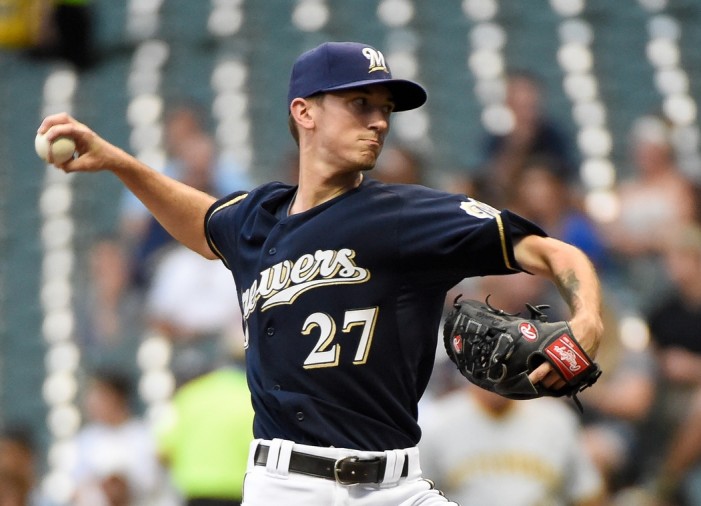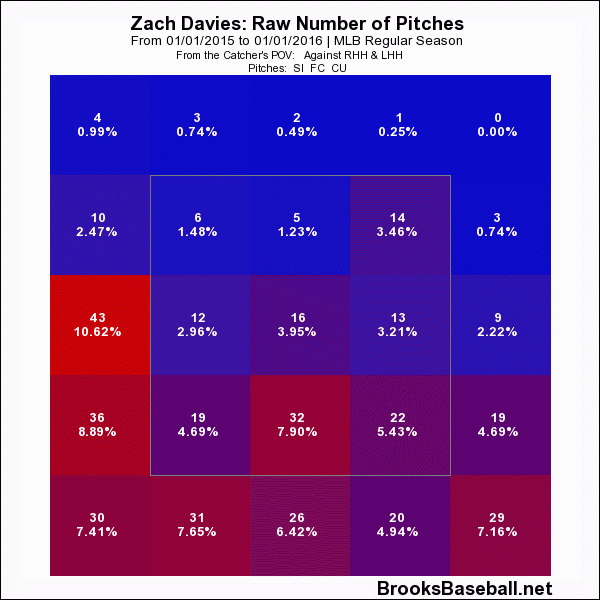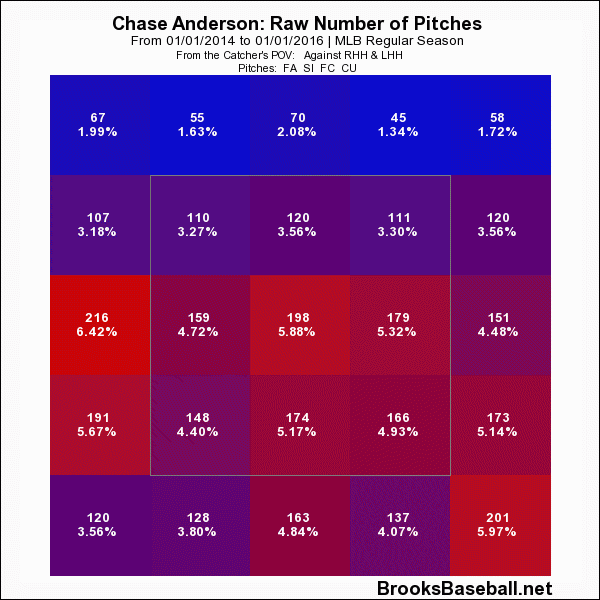Among the many young faces on the Brewers, Chase Anderson is something of a veteran. At age 28, he has 267.0 major-league innings under his belt, meaning he should be able to impart some wisdom on his rotational cohorts. One of them, Zach Davies, shares some traits with Anderson — they both came to Milwaukee in recent trades (for Gerardo Parra and Jean Segura, respectively), and they both have profile as back-end starters with a small amount of mid-rotation potential.
In terms of pitch mix, they have one key thing in common as well. Adam McCalvy wrote an interesting story on Thursday about the changeups that each pitcher throws. This piece made me want to scrutinize the issue further. Just how similar are the cambios that Anderson and Davies employ? Will the latter excel with his, like the former has already done?
Let’s begin with the characteristics of the pitches themselves. Anderson has used his changeup 22.1 percent of the time in his career, while Davies called upon his changeup for 24.9 percent of his pitches in his brief 2015 tryout. In terms of velocity, Anderson (82.2 mph) beats Davies (78.7 mph) significantly. Raw velocity doesn’t mean much, though, when talking changeups. Since Davies has a slower arsenal across the board than Anderson does, they have about the same amount of distance between their fastballs and changeups: Anderson throws his heater 10.1 mph faster, while Davies’s four-seamer travels 10.6 mph above his changeup. The average pitcher has about a nine-mph fastball-changeup differential, and because a larger gap is better, as long as the arm speed and arm slot are similar, this bodes well for both Anderson and Davies.
When it comes to movement, a difference begins to emerge. Anderson’s changeup has sunk an average of 9.9 inches, while running 6.6 inches. In 2015, its vertical and horizontal movement each ranked ninth among the 91 starters with at least 200 pitches, so it really distinguished itself with its bite. Davies’s changeup, by contrast, tallied an average drop of 8.7 inches and run of 4.4 inches; if he had qualified, those would have ranked 29th and 55th, respectively. Not only did it travel slower, it had more mediocre movement in both directions.
Granted, horizontal and vertical movement can only tell a partial story. Davies’s changeup may not move as much, but its deception is superb. Coming out of his hand, it looks exactly like his fastball, which means the amount of movement needed to make the pitch effective is lessened. We can see this in terms of swinging strikes — often considered the definitive pitch-quality metric — because Davies actually wins out. Hitters whiffed at his changeup 27.6 percent of the time; they’ve swung and missed for only 19.1 percent of Anderson’s cambios. Davies didn’t net quite as many strikes (64.2 percent) as Anderson has netted (69.0 percent), but the whiff advantage makes up for that.
It should also be noted that Davies took a very distinct approach with his changeup during his 2015 cup of coffee. More than every other pitch in his repertoire, he buried it:
A total of 62.7 percent of Davies’s changeups went to the lower-fifth of the zone — nearly double the 33.6 percent rate of his other offerings. When hitters didn’t flail helplessly at it, they put it on the ground, giving the pitch a 66.7 percent ground-ball rate. That no contact/weak contact combination made the changeup a blessing for Davies last season.
Anderson also targeted a different area with his changeup — he shifted the whole thing to the left:
There’s a slight downward trend here: 33.2 percent of Anderson’s changeups fell below the strike zone, compared with just 22.2 percent of his other pitches. It’s nowhere near the same amount as Davies, though. Anderson’s offering has much more horizontal movement on it than Davies’s does, which may mean that he slides it horizontally. Whatever the cause, Anderson’s pitch has a great deal of value, but it still seems to lag behind Davies’s.
Two final differences emerge between the two pitches, regarding their situational usage. Davies utilized his changeup far more often against righties than Anderson has, and he’s relied on it more heavily with two strikes. In other words, it’s his out-pitch.
| Pitcher | Lefty% | Righty% | 2 Strike% |
|---|---|---|---|
| Anderson | 27.7% | 17.3% | 26.7% |
| Davies | 27.8% | 22.3% | 32.9% |
Changeups can carry reverse platoon splits, so pounding same-handed batters with them presents some risk. Likewise, a pitcher will generally reserve his best pitch for the putaway opportunities. Despite his inexperience, Davies seems to trust his changeup immensely, and the results bear that out. While Anderson has some faith in his, his play might improve if he leaned on it a bit more.
In the 2016 Brewers prospect writeup, BP gave Davies’s changeup a future grade of 70, meaning it could become elite someday. Should it maintain its 2015 production, it’ll certainly rank among the game’s best pitches. Anderson has a superb cambio as well, but his younger counterpart appears to have him beat. As the two continue to pick each other’s brains in camp, maybe Anderson will reach Davies’s level — and maybe Davies will get even better. One elite pitch does not a top starter make; for these hurlers, though, the changeup can be a ticket to a regular job.



1 comment on “Chase Anderson and Zach Davies: Masters of the Changeup”